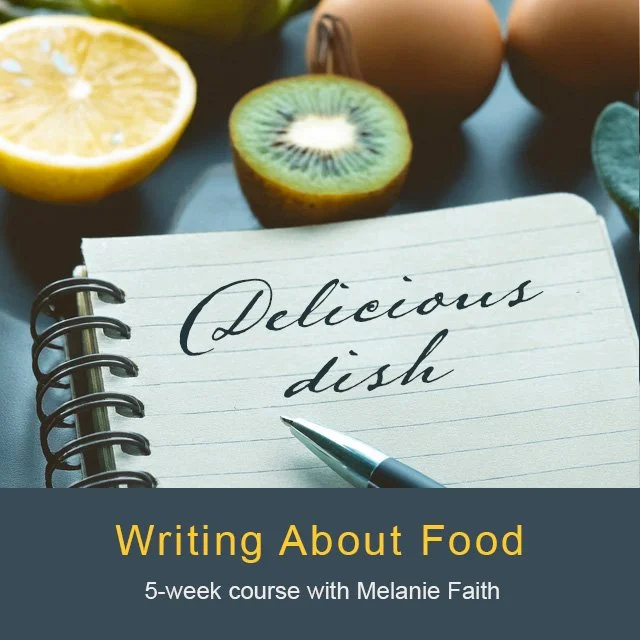So happy that my latest article was published at Women on Writing today!
Fabulous Food Lingo and 5 Sumptuous, Savory Prompts to Try
By Melanie Faith
Most writers are word lovers. We delight in the fun of stringing each little consonant cluster together.
What might writers adore just as much as the flair of finding just the right synonym or antonym to tell our tales? What pairs well with an appetizer of theme and a garnish of motif and a heaping helping of diction choices with a fresh ooey-gooey slice of second-draft pie?
Why, food, of course!
Food combines a topic that is both highly relatable and rigorously individualistic. Food writing promises: Sure, we’ve all had salad, but we’ve not all described this heavenly pasta salad from Café Romano on Spruce Street or that delectable BBQ Uncle Ross used to bring to every family function with a tangy sauce so top-secret aunts, uncles, and several second cousins are still trying to figure out and reproduce it (almost successfully) for each year’s reunion.
Food is inextricably connected to memory, place, and time. Food is both growing up and growing into our better selves.
Food is also undeniably literary. From Proust’s super famous madeleine to the descriptions of bread, cookies, and cakes (along with those mouth-watering photos) in your favorite print cookbooks or online recipes, food is tied to expression, especially self-expression in relation to our connections with others. Food is also the guilty pleasure stashed in the top or back shelf of the pantry (Shh…, I won’t tell).
Yes, just like writing, the foods and meals we make, buy, and/or share (or keep for ourselves) provide endless possibilities for creativity—from the individual ingredients to the finished dish on the platter someone gave to great grandma so long ago no one knows where she acquired it but now this treasure is yours.
We often speak of food enthusiastically in conversation with family and friends, so why not write about food the same way?
Try a few of these ideas the next time you’re searching for something to write and want to get words flowing in yummy formation:
Food-jar fiesta: Get a glass jar (recycled or new) and fill it with scraps of food phrases, one on each small piece of paper. Or page through a print cookbook for topic ideas. Love surprises? Get a friend, partner, child, or fellow writer to contribute ideas to the jar for you. Draw one scrap a week for a free-write. If you really enjoy choosing from the jar (like the best sweets, it can get kind of addictive), feel free to dip into it a few times a week. Once you’ve worked your way through the jar, reload it and write on!
Make a food-word alphabet: Write A-Z down the left-hand side of a piece of paper. Quickly jot down any food-related word you can think for each letter. Feel free to do a second draft of this list where you use a search engine to add additional words to the list from recipes, cookbooks, or watching cooking shows. Keep this list handy at your desk for future free-writes.
The recipe nobody wants: Write down four or five places where people meet. Then, pick one as your setting. Write for fifteen minutes about a recipe that your character doesn’t want and that others don’t want to eat, and yet…circumstances or traditions dictate they must make and eat this dish. Include body language and some dialogue in a second draft. This prompt is great for exploring tone—from humor to dread—and an excellent way to practice describing various textures of foods we don’t enjoy.
The nose knows: Write for 15 minutes about a food you would recognize anywhere, from smell alone. This is a great way to practice descriptive writing and making your readers hungry!
Ask, and it’s yours: Write down a few food-related questions to ask someone in your family or friend circle. Conduct an informal interview where you supply the treats (or a favorite meeting-place does) and you take notes on your friend’s (and your own!) answers one afternoon. You can also do this exercise as a free-write and then swap each other’s answers to read aloud after writing. Some fun options may include: asking if they recall a favorite food or recipe from growing-up years and its origin; asking how, when, or where they learned to cook; asking them to describe a recipe they made that went wrong and what happened (be ready to laugh). This exercise can also be repeated at various times of year, with both longtime friends and new.
Also, check out my latest online writing class (beginning Friday, Oct. 10th): clickety-click.
Courtesy of Women on Writing.














